Page 8 of 265
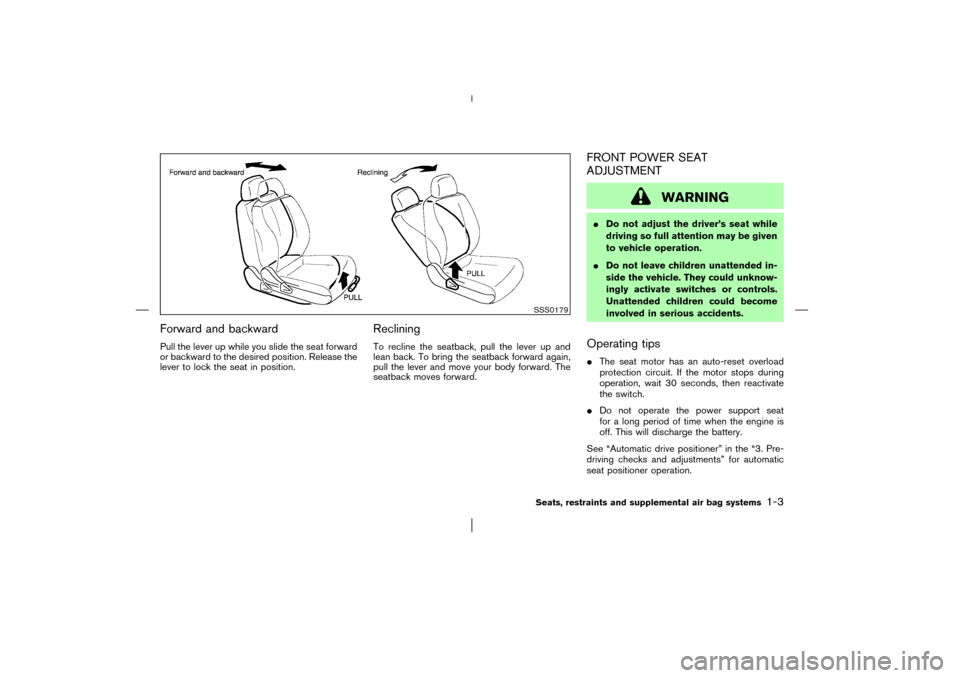
Forward and backwardPull the lever up while you slide the seat forward
or backward to the desired position. Release the
lever to lock the seat in position.
RecliningTo recline the seatback, pull the lever up and
lean back. To bring the seatback forward again,
pull the lever and move your body forward. The
seatback moves forward.
FRONT POWER SEAT
ADJUSTMENT
WARNING
�Do not adjust the driver’s seat while
driving so full attention may be given
to vehicle operation.
�Do not leave children unattended in-
side the vehicle. They could unknow-
ingly activate switches or controls.
Unattended children could become
involved in serious accidents.Operating tips�The seat motor has an auto-reset overload
protection circuit. If the motor stops during
operation, wait 30 seconds, then reactivate
the switch.
�Do not operate the power support seat
for a long period of time when the engine is
off. This will discharge the battery.
See “Automatic drive positioner” in the “3. Pre-
driving checks and adjustments” for automatic
seat positioner operation.
SSS0179Seats, restraints and supplemental air bag systems
1-3
�
03.1.28/Z50-D/V5.0
�
Page 31 of 265
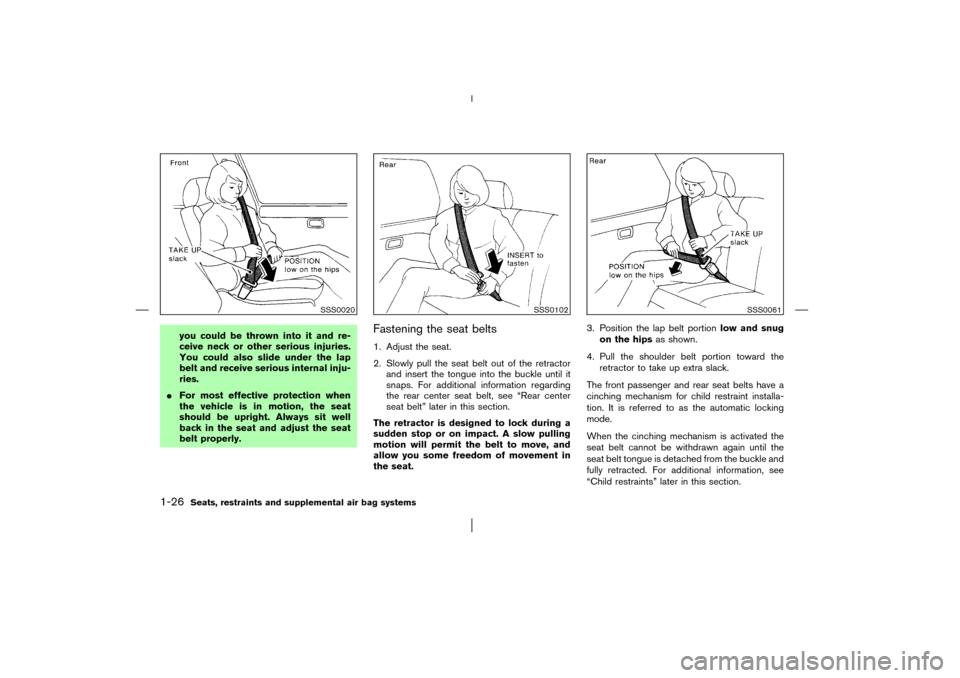
you could be thrown into it and re-
ceive neck or other serious injuries.
You could also slide under the lap
belt and receive serious internal inju-
ries.
�For most effective protection when
the vehicle is in motion, the seat
should be upright. Always sit well
back in the seat and adjust the seat
belt properly.
Fastening the seat belts1. Adjust the seat.
2. Slowly pull the seat belt out of the retractor
and insert the tongue into the buckle until it
snaps. For additional information regarding
the rear center seat belt, see “Rear center
seat belt” later in this section.
The retractor is designed to lock during a
sudden stop or on impact. A slow pulling
motion will permit the belt to move, and
allow you some freedom of movement in
the seat.3. Position the lap belt portionlow and snug
on the hipsas shown.
4. Pull the shoulder belt portion toward the
retractor to take up extra slack.
The front passenger and rear seat belts have a
cinching mechanism for child restraint installa-
tion. It is referred to as the automatic locking
mode.
When the cinching mechanism is activated the
seat belt cannot be withdrawn again until the
seat belt tongue is detached from the buckle and
fully retracted. For additional information, see
“Child restraints” later in this section.
SSS0020
SSS0102
SSS0061
1-26
Seats, restraints and supplemental air bag systems
�
03.1.28/Z50-D/V5.0
�
Page 32 of 265
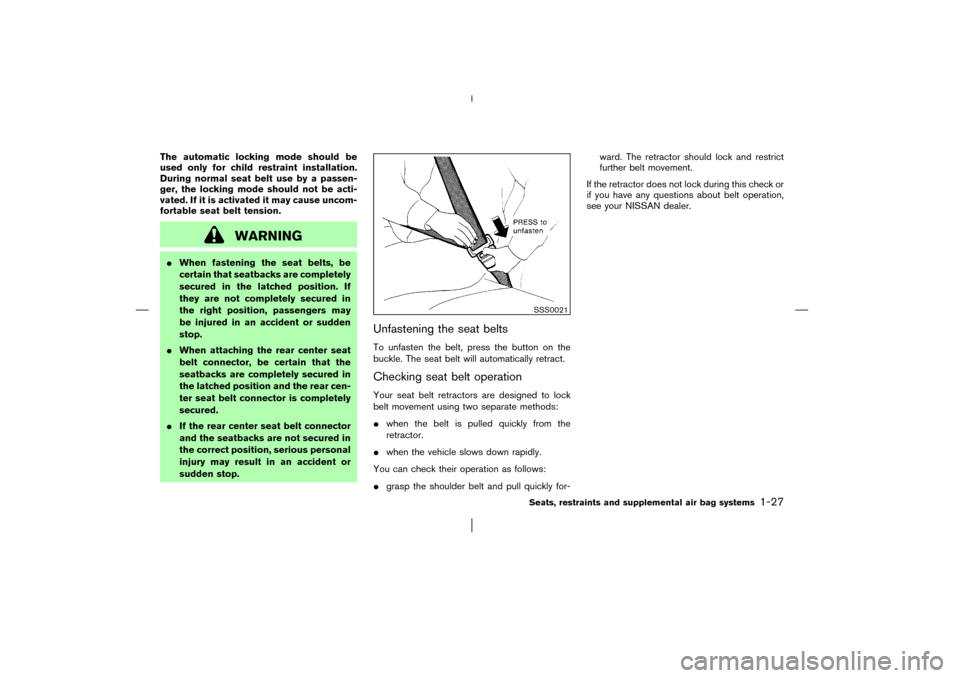
The automatic locking mode should be
used only for child restraint installation.
During normal seat belt use by a passen-
ger, the locking mode should not be acti-
vated. If it is activated it may cause uncom-
fortable seat belt tension.
WARNING
�When fastening the seat belts, be
certain that seatbacks are completely
secured in the latched position. If
they are not completely secured in
the right position, passengers may
be injured in an accident or sudden
stop.
�When attaching the rear center seat
belt connector, be certain that the
seatbacks are completely secured in
the latched position and the rear cen-
ter seat belt connector is completely
secured.
�If the rear center seat belt connector
and the seatbacks are not secured in
the correct position, serious personal
injury may result in an accident or
sudden stop.
Unfastening the seat beltsTo unfasten the belt, press the button on the
buckle. The seat belt will automatically retract.Checking seat belt operationYour seat belt retractors are designed to lock
belt movement using two separate methods:
�when the belt is pulled quickly from the
retractor.
�when the vehicle slows down rapidly.
You can check their operation as follows:
�grasp the shoulder belt and pull quickly for-ward. The retractor should lock and restrict
further belt movement.
If the retractor does not lock during this check or
if you have any questions about belt operation,
see your NISSAN dealer.
SSS0021Seats, restraints and supplemental air bag systems
1-27
�
03.1.28/Z50-D/V5.0
�
Page 39 of 265

must install a front facing child re-
straint in the front seat, see instruc-
tions later in this section.
�When your child restraint is not in
use, store it in the trunk or keep it
secured with a seat belt to prevent it
from being thrown around in case of
a sudden stop or accident.
CAUTION
Remember that a child restraint left in a
closed vehicle can become very hot.
Check the seating surface and buckles
before placing your child in the child
restraint.
INSTALLATION ON REAR SEAT
CENTER OR OUTBOARD
POSITIONS
WARNING
�The three-point rear seat belts on
your vehicle are equipped with a
locking mode retractor which must
be used when installing a child re-
straint.
�Failure to do so will result in the child
restraint not being properly secured.
It could tip over or otherwise be un-
secured and cause injury to the child
in a sudden stop or collision.
�When installing a child restraint sys-
tem in the rear center position, both
the center seat belt connector tongue
and buckle tongue must be secured.
See “Attaching rear center seat belt”
earlier in this section.
Front facingWhen you install a child restraint in a rear
outboard or center seat, follow these steps:
1. Position the child restraint on the seat. It can
be placed in a front facing direction, depend-
ing on the size of the child. Always follow the
restraint manufacturer’s instructions.
SSS0153
1-34
Seats, restraints and supplemental air bag systems
�
03.1.28/Z50-D/V5.0
�
Page 40 of 265
2. Route the seat belt tongue through the child
restraint and insert it into the buckle until you
hear and feel the latch engage.
Be sure to follow the child restraint manufac-
turer’s instructions for belt routing.3. Pull on the shoulder belt until all of the belt is
fully extended. At this time, the belt retractor
is in the automatic locking mode (child re-
straint mode). It reverts back to emergency
locking mode when the belt is fully retracted.
SSS0239
SSS0043
SSS0107
Seats, restraints and supplemental air bag systems
1-35
�
03.1.28/Z50-D/V5.0
�
Page 41 of 265
4. Allow the belt to retract. Pull up on the belt to
remove any slack in the belt.5. Before placing the child in the child restraint,
use force to tilt the child restraint from side to
side, and tug it forward to make sure that it is
securely held in place.
6. Check that the retractor is in the automatic
locking mode by trying to pull more belt out of
the retractor. If you cannot pull any more belt
webbing out of the retractor, the belt is in the
automatic locking mode.
7. Check to make sure that the child restraint is
properly secured prior to each use. If the belt
is not locked, repeat steps 3 through 6.
After the child restraint is removed and the seat
belt is allowed to wind back into the retractor,the automatic locking mode (child restraint
mode) is canceled; the seat belt only locks
during a sudden stop or impact.
SSS0062
SSS0108
1-36
Seats, restraints and supplemental air bag systems
�
03.1.28/Z50-D/V5.0
�
Page 43 of 265
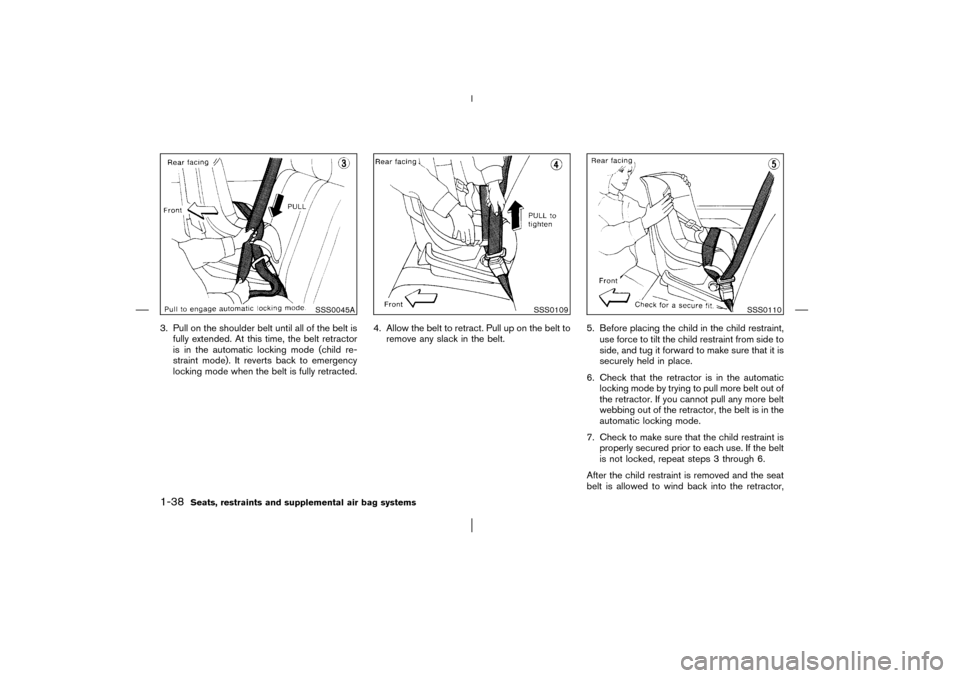
3. Pull on the shoulder belt until all of the belt is
fully extended. At this time, the belt retractor
is in the automatic locking mode (child re-
straint mode). It reverts back to emergency
locking mode when the belt is fully retracted.4. Allow the belt to retract. Pull up on the belt to
remove any slack in the belt.5. Before placing the child in the child restraint,
use force to tilt the child restraint from side to
side, and tug it forward to make sure that it is
securely held in place.
6. Check that the retractor is in the automatic
locking mode by trying to pull more belt out of
the retractor. If you cannot pull any more belt
webbing out of the retractor, the belt is in the
automatic locking mode.
7. Check to make sure that the child restraint is
properly secured prior to each use. If the belt
is not locked, repeat steps 3 through 6.
After the child restraint is removed and the seat
belt is allowed to wind back into the retractor,
SSS0045A
SSS0109
SSS0110
1-38
Seats, restraints and supplemental air bag systems
�
03.1.28/Z50-D/V5.0
�
Page 44 of 265
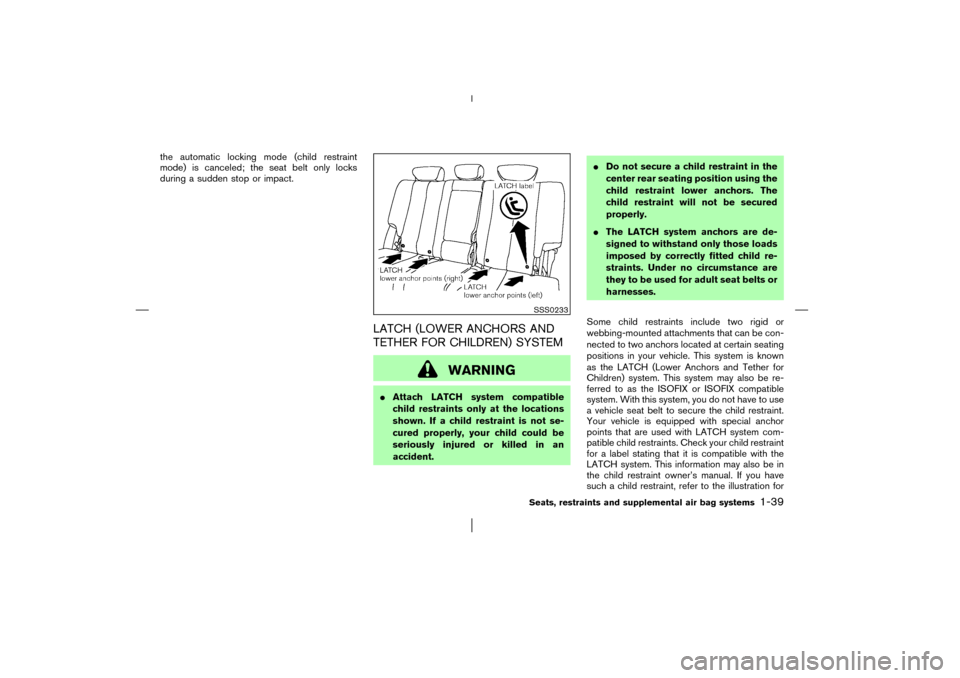
the automatic locking mode (child restraint
mode) is canceled; the seat belt only locks
during a sudden stop or impact.
LATCH (LOWER ANCHORS AND
TETHER FOR CHILDREN) SYSTEM
WARNING
�Attach LATCH system compatible
child restraints only at the locations
shown. If a child restraint is not se-
cured properly, your child could be
seriously injured or killed in an
accident.�Do not secure a child restraint in the
center rear seating position using the
child restraint lower anchors. The
child restraint will not be secured
properly.
�The LATCH system anchors are de-
signed to withstand only those loads
imposed by correctly fitted child re-
straints. Under no circumstance are
they to be used for adult seat belts or
harnesses.
Some child restraints include two rigid or
webbing-mounted attachments that can be con-
nected to two anchors located at certain seating
positions in your vehicle. This system is known
as the LATCH (Lower Anchors and Tether for
Children) system. This system may also be re-
ferred to as the ISOFIX or ISOFIX compatible
system. With this system, you do not have to use
a vehicle seat belt to secure the child restraint.
Your vehicle is equipped with special anchor
points that are used with LATCH system com-
patible child restraints. Check your child restraint
for a label stating that it is compatible with the
LATCH system. This information may also be in
the child restraint owner’s manual. If you have
such a child restraint, refer to the illustration for
SSS0233Seats, restraints and supplemental air bag systems
1-39
�
03.1.28/Z50-D/V5.0
�